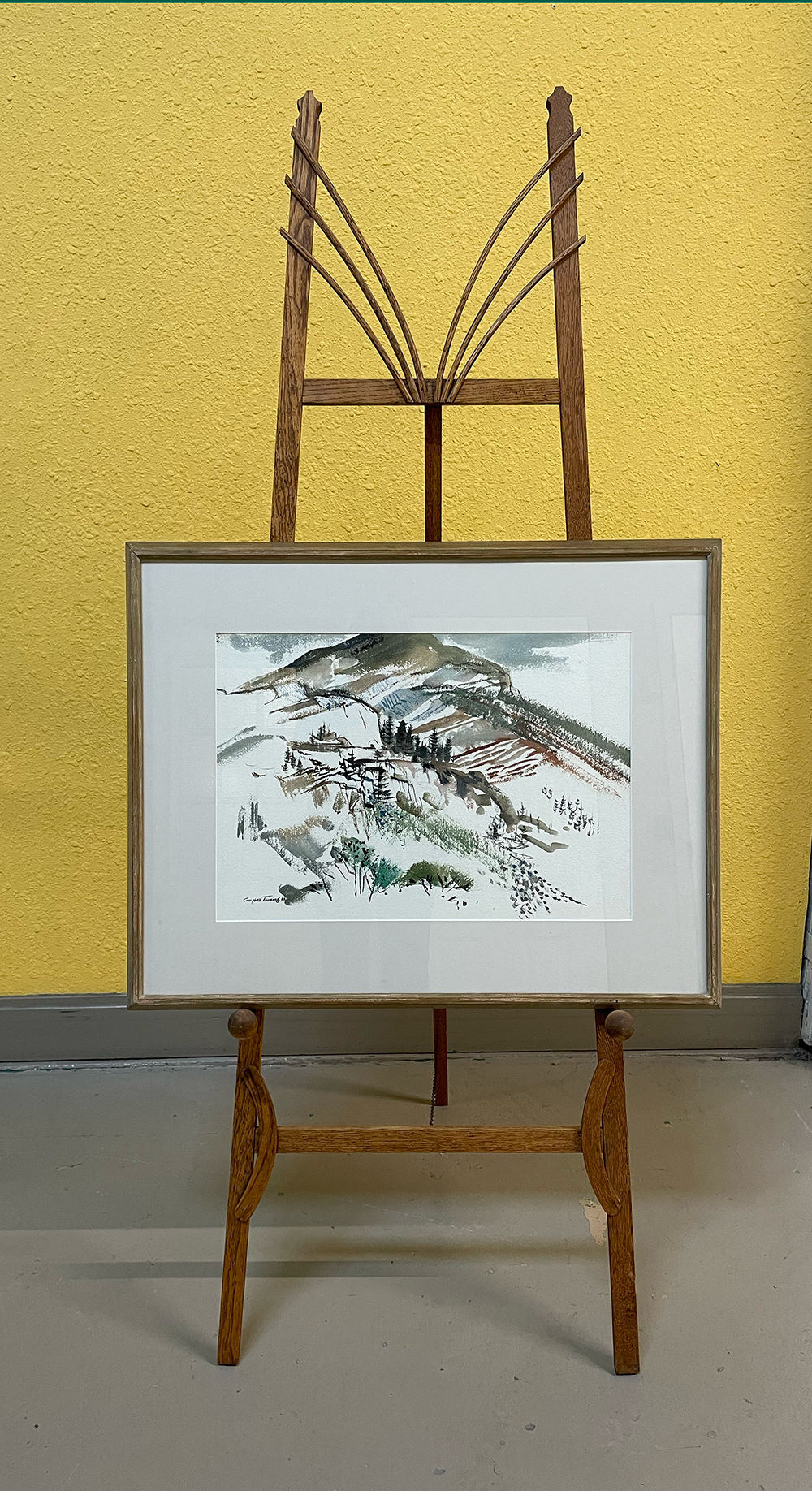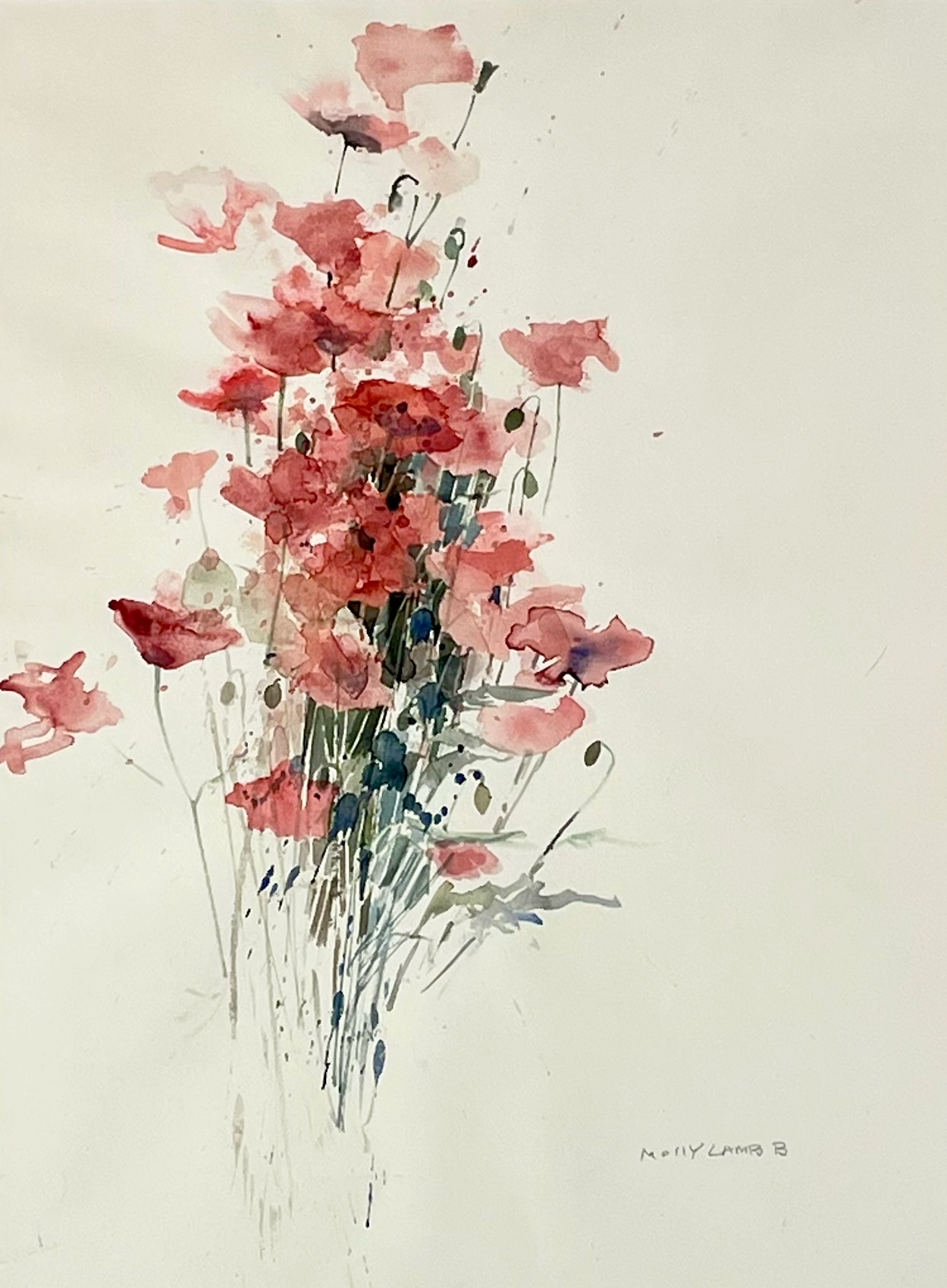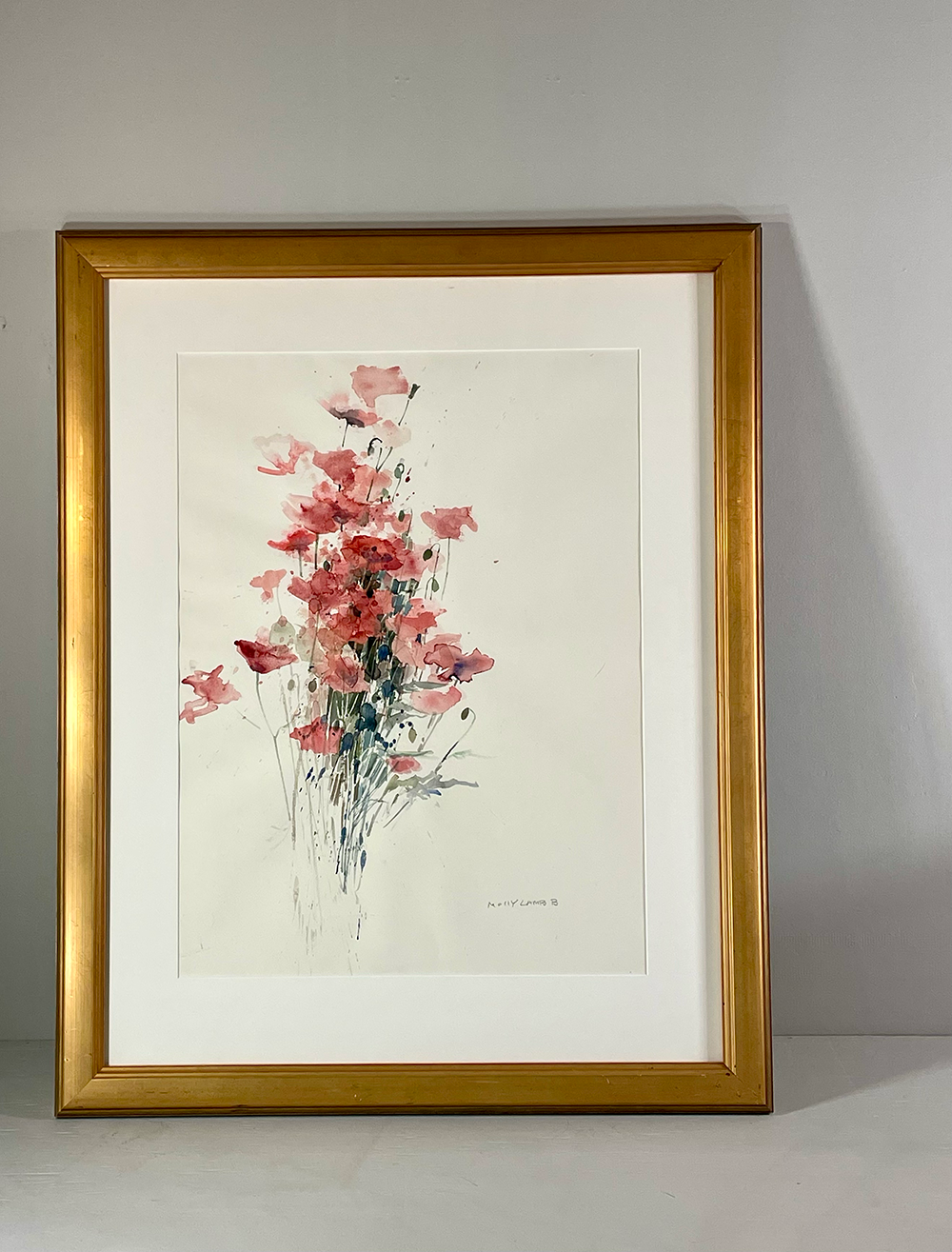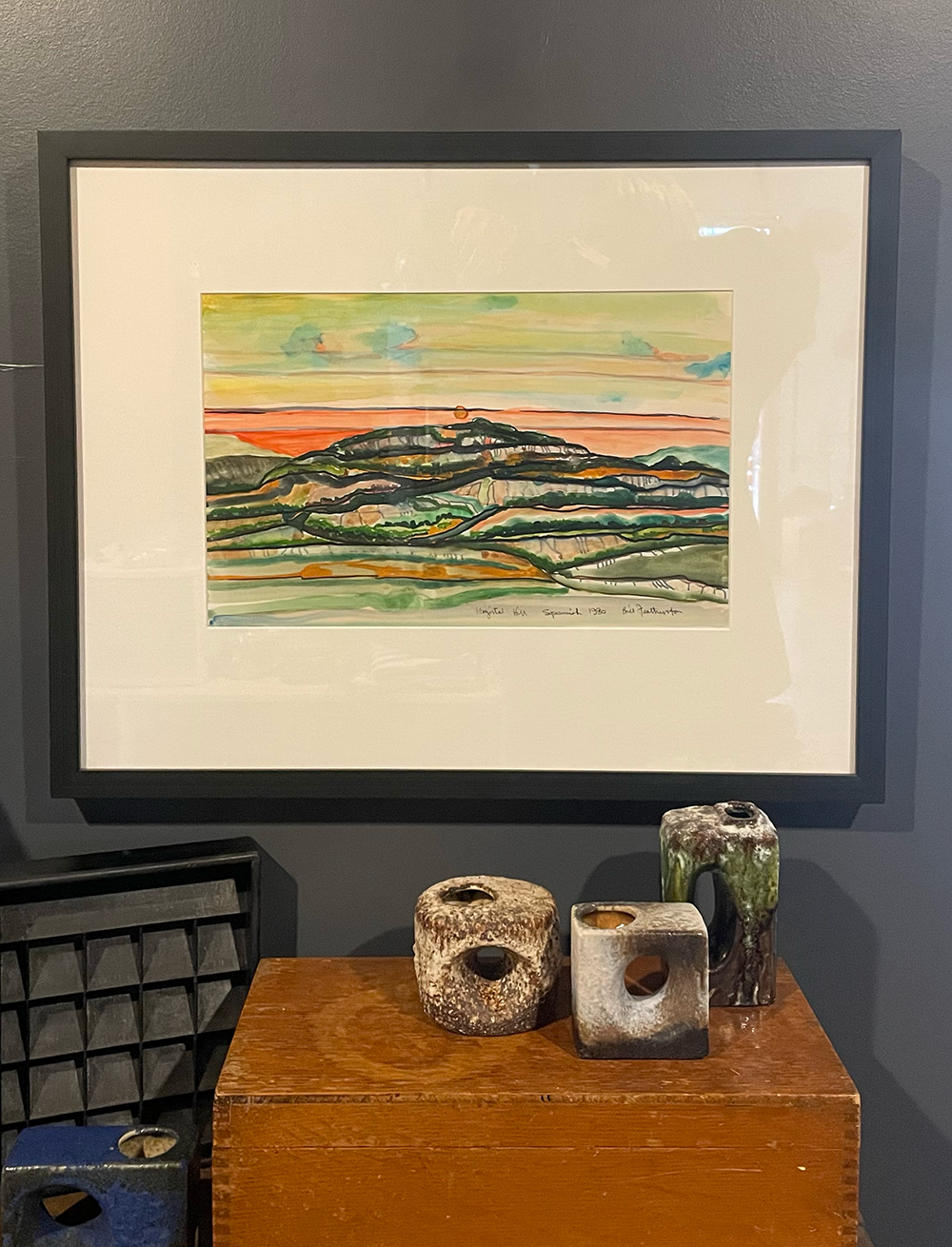 Image 1 of 5
Image 1 of 5

 Image 2 of 5
Image 2 of 5

 Image 3 of 5
Image 3 of 5

 Image 4 of 5
Image 4 of 5

 Image 5 of 5
Image 5 of 5






G. Campbell Tinning, Naramata Little Tunnel, en plein air watercolour 1962
George Campbell Tinning’s watercolours are lush and expansive and full of colour, generally filling the paper edge to edge. However, on a plein air painting afternoon with Percy M. Ritchie (Canadian 1917 - 2004) she urged him to stop when he reached a certain minimalist point in his painting of the Little Tunnel that overlooks Naramata from the northeast along the Kettle Valley Railway. She then added this painting to her personal collection.
G. Campbell Tinning (1910 - 1996) RCA
Naramata Little Tunnel
en plein air watercolour, 1962
by descent from the Ritchie family
Original frame, 24” x 30” with an archival mat but otherwise all original. Please note there is a scratch in the glass.
Please contact us if you require shipping. We use Canada Post. Personal delivery is also available for a flat rate of $40 plus GST to the Okanagan and Lower Mainland during our scheduled trips.
George Campbell Tinning was born in 1910 in Saskatoon, Saskatchewan, and grew up in Winnipeg, Manitoba, and Regina, Saskatchewan. He took art classes in Regina until 1938, when he went to study painting at Eliot O'Hara's Watercolour School in Goose Rocks, Maine and at the Art Students' League in New York under Arnold Blanche and William Palmer.
Tinning's first exhibition took place in 1938 at the Pennsylvania Academy of the Fine Arts in Philadelphia. The next year, he moved to Montreal, where he worked as a graphic artist for Robert Simpson Ltd.
In 1942, Tinning began military service with the Black Watch Royal Highlanders of Canada and served as an official Canadian war artist in Halifax, Sussex, Italy, Belgium, and Holland. He returned to Montreal after the war and continued to paint watercolour and oil landscapes, while teaching watercolour painting in the evenings.
From 1950 to 1969, Tinning worked as an illustrator for Ford Motor Company's magazine Lincoln-Mercury Times, a job that allowed him to travel around the world, making sketches of travel destinations. He was the recipient of many commissions, including from the Manoir Hotel (Baie Comeau, Quebec) and the Montreal Museum of Fine Arts.
Tinning's subject matter was as diverse as one might expect, given his life and travels. He painted scenes from his rural prairie upbringing, east coast fishing villages, Montreal's downtown and London streets, as well as floral still lifes and figurative works.
Campbell Tinning spent many holidays in Naramata and the Okanagan as several family members resided (and still reside) in the region. His watercolours of the Naramata hills and beaches, and Okanagan Lake and orchards hold special significance for locals and visitors alike.
Tinning has won numerous awards for his work, including the Art Association of Montreal's Jessie Dow Prize (1942, 1948). In 1953, Tinning became an associate of the Royal Canadian Academy of Arts (and became a full member in 1970).
Tinning's paintings are part of the collections of the National Gallery of Canada, the National War Museum, the National Archives of Canada, and several other public and private collections.
Tinning died in Montreal in 1996.
…………….
Percival M. Ritchie, 1917 - 2004, (nee MacKenzie) was born on July 9, 1917 at Pointe-au-Pic in Quebec’s Charlevoix region. During her formative teen years she studied at an all girls private school called “The Study” under Ethel Seath, who was also part of the Beaver Hall Group of painters.
At nineteen, (now the mid 1930’s), Ritchie set out to study art in Paris, where she studied academic drawing at Atelier Miguet. Two years later, she was back in Montreal studying at the Art Association of Montreal. There, she studied under several influential instructors, the most notable being Goodrich Roberts and Edwin Holgate. She would later go on to study with Arthur Lismer of the Group of Seven.
By 1942, Ritchie was already a respected artist when she married Fred Ritchie. Her and her husband shared a dream of living a rural life away from the city and in 1956, together with their 4 children, the family moved to Naramata, BC and realized their dream when they bought a mixed fruit orchard.
While raising children, taking care of the home and orchard, Ritchie continued to produce paintings and drawings, and in between those projects, would make small prints on large pieces of paper using the technique of stone lithography.
Percy and Fred flourished in Naramata, and each left their enduring mark on the village; Percy left behind murals both in the local community church and at the Naramata Centre.
Percy Ritchie passed away in Penticton in 2004.
George Campbell Tinning’s watercolours are lush and expansive and full of colour, generally filling the paper edge to edge. However, on a plein air painting afternoon with Percy M. Ritchie (Canadian 1917 - 2004) she urged him to stop when he reached a certain minimalist point in his painting of the Little Tunnel that overlooks Naramata from the northeast along the Kettle Valley Railway. She then added this painting to her personal collection.
G. Campbell Tinning (1910 - 1996) RCA
Naramata Little Tunnel
en plein air watercolour, 1962
by descent from the Ritchie family
Original frame, 24” x 30” with an archival mat but otherwise all original. Please note there is a scratch in the glass.
Please contact us if you require shipping. We use Canada Post. Personal delivery is also available for a flat rate of $40 plus GST to the Okanagan and Lower Mainland during our scheduled trips.
George Campbell Tinning was born in 1910 in Saskatoon, Saskatchewan, and grew up in Winnipeg, Manitoba, and Regina, Saskatchewan. He took art classes in Regina until 1938, when he went to study painting at Eliot O'Hara's Watercolour School in Goose Rocks, Maine and at the Art Students' League in New York under Arnold Blanche and William Palmer.
Tinning's first exhibition took place in 1938 at the Pennsylvania Academy of the Fine Arts in Philadelphia. The next year, he moved to Montreal, where he worked as a graphic artist for Robert Simpson Ltd.
In 1942, Tinning began military service with the Black Watch Royal Highlanders of Canada and served as an official Canadian war artist in Halifax, Sussex, Italy, Belgium, and Holland. He returned to Montreal after the war and continued to paint watercolour and oil landscapes, while teaching watercolour painting in the evenings.
From 1950 to 1969, Tinning worked as an illustrator for Ford Motor Company's magazine Lincoln-Mercury Times, a job that allowed him to travel around the world, making sketches of travel destinations. He was the recipient of many commissions, including from the Manoir Hotel (Baie Comeau, Quebec) and the Montreal Museum of Fine Arts.
Tinning's subject matter was as diverse as one might expect, given his life and travels. He painted scenes from his rural prairie upbringing, east coast fishing villages, Montreal's downtown and London streets, as well as floral still lifes and figurative works.
Campbell Tinning spent many holidays in Naramata and the Okanagan as several family members resided (and still reside) in the region. His watercolours of the Naramata hills and beaches, and Okanagan Lake and orchards hold special significance for locals and visitors alike.
Tinning has won numerous awards for his work, including the Art Association of Montreal's Jessie Dow Prize (1942, 1948). In 1953, Tinning became an associate of the Royal Canadian Academy of Arts (and became a full member in 1970).
Tinning's paintings are part of the collections of the National Gallery of Canada, the National War Museum, the National Archives of Canada, and several other public and private collections.
Tinning died in Montreal in 1996.
…………….
Percival M. Ritchie, 1917 - 2004, (nee MacKenzie) was born on July 9, 1917 at Pointe-au-Pic in Quebec’s Charlevoix region. During her formative teen years she studied at an all girls private school called “The Study” under Ethel Seath, who was also part of the Beaver Hall Group of painters.
At nineteen, (now the mid 1930’s), Ritchie set out to study art in Paris, where she studied academic drawing at Atelier Miguet. Two years later, she was back in Montreal studying at the Art Association of Montreal. There, she studied under several influential instructors, the most notable being Goodrich Roberts and Edwin Holgate. She would later go on to study with Arthur Lismer of the Group of Seven.
By 1942, Ritchie was already a respected artist when she married Fred Ritchie. Her and her husband shared a dream of living a rural life away from the city and in 1956, together with their 4 children, the family moved to Naramata, BC and realized their dream when they bought a mixed fruit orchard.
While raising children, taking care of the home and orchard, Ritchie continued to produce paintings and drawings, and in between those projects, would make small prints on large pieces of paper using the technique of stone lithography.
Percy and Fred flourished in Naramata, and each left their enduring mark on the village; Percy left behind murals both in the local community church and at the Naramata Centre.
Percy Ritchie passed away in Penticton in 2004.
George Campbell Tinning’s watercolours are lush and expansive and full of colour, generally filling the paper edge to edge. However, on a plein air painting afternoon with Percy M. Ritchie (Canadian 1917 - 2004) she urged him to stop when he reached a certain minimalist point in his painting of the Little Tunnel that overlooks Naramata from the northeast along the Kettle Valley Railway. She then added this painting to her personal collection.
G. Campbell Tinning (1910 - 1996) RCA
Naramata Little Tunnel
en plein air watercolour, 1962
by descent from the Ritchie family
Original frame, 24” x 30” with an archival mat but otherwise all original. Please note there is a scratch in the glass.
Please contact us if you require shipping. We use Canada Post. Personal delivery is also available for a flat rate of $40 plus GST to the Okanagan and Lower Mainland during our scheduled trips.
George Campbell Tinning was born in 1910 in Saskatoon, Saskatchewan, and grew up in Winnipeg, Manitoba, and Regina, Saskatchewan. He took art classes in Regina until 1938, when he went to study painting at Eliot O'Hara's Watercolour School in Goose Rocks, Maine and at the Art Students' League in New York under Arnold Blanche and William Palmer.
Tinning's first exhibition took place in 1938 at the Pennsylvania Academy of the Fine Arts in Philadelphia. The next year, he moved to Montreal, where he worked as a graphic artist for Robert Simpson Ltd.
In 1942, Tinning began military service with the Black Watch Royal Highlanders of Canada and served as an official Canadian war artist in Halifax, Sussex, Italy, Belgium, and Holland. He returned to Montreal after the war and continued to paint watercolour and oil landscapes, while teaching watercolour painting in the evenings.
From 1950 to 1969, Tinning worked as an illustrator for Ford Motor Company's magazine Lincoln-Mercury Times, a job that allowed him to travel around the world, making sketches of travel destinations. He was the recipient of many commissions, including from the Manoir Hotel (Baie Comeau, Quebec) and the Montreal Museum of Fine Arts.
Tinning's subject matter was as diverse as one might expect, given his life and travels. He painted scenes from his rural prairie upbringing, east coast fishing villages, Montreal's downtown and London streets, as well as floral still lifes and figurative works.
Campbell Tinning spent many holidays in Naramata and the Okanagan as several family members resided (and still reside) in the region. His watercolours of the Naramata hills and beaches, and Okanagan Lake and orchards hold special significance for locals and visitors alike.
Tinning has won numerous awards for his work, including the Art Association of Montreal's Jessie Dow Prize (1942, 1948). In 1953, Tinning became an associate of the Royal Canadian Academy of Arts (and became a full member in 1970).
Tinning's paintings are part of the collections of the National Gallery of Canada, the National War Museum, the National Archives of Canada, and several other public and private collections.
Tinning died in Montreal in 1996.
…………….
Percival M. Ritchie, 1917 - 2004, (nee MacKenzie) was born on July 9, 1917 at Pointe-au-Pic in Quebec’s Charlevoix region. During her formative teen years she studied at an all girls private school called “The Study” under Ethel Seath, who was also part of the Beaver Hall Group of painters.
At nineteen, (now the mid 1930’s), Ritchie set out to study art in Paris, where she studied academic drawing at Atelier Miguet. Two years later, she was back in Montreal studying at the Art Association of Montreal. There, she studied under several influential instructors, the most notable being Goodrich Roberts and Edwin Holgate. She would later go on to study with Arthur Lismer of the Group of Seven.
By 1942, Ritchie was already a respected artist when she married Fred Ritchie. Her and her husband shared a dream of living a rural life away from the city and in 1956, together with their 4 children, the family moved to Naramata, BC and realized their dream when they bought a mixed fruit orchard.
While raising children, taking care of the home and orchard, Ritchie continued to produce paintings and drawings, and in between those projects, would make small prints on large pieces of paper using the technique of stone lithography.
Percy and Fred flourished in Naramata, and each left their enduring mark on the village; Percy left behind murals both in the local community church and at the Naramata Centre.
Percy Ritchie passed away in Penticton in 2004.















